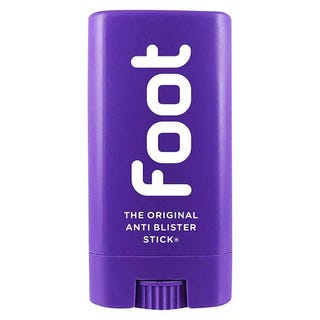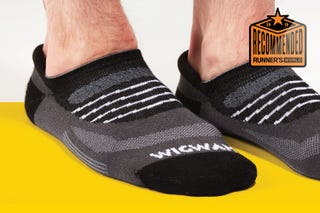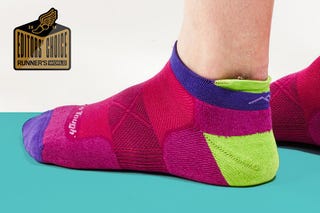How to Get Rid of Water Blisters on Feet
- To prevent blisters, ensure you are wearing properly fitting shoes and socks.
- Yes, you can run with blisters, but you should make sure they are protected with a clean bandage and dry socks.
- Proper blister treatment will ensure your wounds heal quickly.
Annoying and painful, blisters are caused by friction, usually your shoes or socks rubbing against your skin. Anything that intensifies rubbing can start a blister, including a faster pace, poor-fitting shoes, and foot abnormalities such as bunions, heel spurs, and hammertoes. Bad blisters, and improper blister treatment, can cut into your training. During race prep and racing, proper blister treatment—including prevention—is key.
Additionally, heat and moisture, which can cause your feet to swell, can also intensify friction. That explains why many of us only suffer blisters during races, especially marathons, during which you perspire more, run faster and longer, and slosh through aid stations.
The body responds to this friction by producing fluid, which builds up beneath the part of the skin being rubbed, causing pressure and pain. When the friction is so bad that it ruptures tiny blood vessels, that causes a blood blister.
While most blisters don't pose a serious health risk, they should be treated with respect. "A painful blister can sideline a runner," says Letha Griffin, M.D., an orthopedic surgeon in Atlanta, and sports physician for Georgia State University. But more importantly, "a blister also can get infected. And those infections can put you in the hospital," she adds. "A lot of people will pop a blister with a dirty needle, and the area will get infected. Then, all of a sudden, you've got a severe problem."
To avoid landing in the emergency room due to an issue as small as a blister, here is what you should keep in mind for at-home blister treatment.
Blister Treatment
If you have a large, painful blister, drain it. If you don't drain it, your blister will hurt, and it could puncture on its own, says Sheldon Laps, D.P.M., podiatrist and foot surgeon in Washington, D.C.
To drain the blister, wash your hands, then wipe a needle with alcohol to sterilize it. "Don't put the needle in a flame; you'll get carbon particles in your skin," Laps says. The carbon can further irritate the wound.
Once you've punctured the blister, carefully drain the liquid by pushing gently with your fingers near the hole. Then cover the blister with a tight, clean bandage to keep bacteria from getting in.
You can take the bandage off periodically and soak your foot in Epsom salts (follow package directions) to draw out the fluid. After soaking, dry the skin thoroughly, and put on a fresh bandage. "It's a good idea to keep a bandage on until the skin tightens up again," Laps says.
If you have a small blister that isn't bothering you, leave it intact. The skin acts as a protective covering over a sterile environment. Furthermore, if the fluid amount is small and you try to pop it, you could cause additional problems by making it bleed. Leave small blood blisters intact, too. Otherwise, you risk getting bacteria into your bloodstream.
For small blisters, cut a hole the size of the blister in the middle of a piece of moleskin, then place it over the blister and cover it with gauze. The blister will dry out and heal on its own.
A blister under a nail is best treated by a professional. "If it's under the base of the toenail, we take an electric file and drill a hole," Laps explains, adding, "You never want to deliberately remove the toenail."
Blister Treatment Tool Kit


BodyGlide Foot Anti Blister Balm

KT Tape Blister Treatment Patch

Vaseline 100% Pure Petroleum Jelly
Blister Prevention
While it's good to know what to do with a blister once you have one, it's even better to stop one from forming before it starts. Here are some expert tips for preventing blisters from sidelining your run.
Hydrate Your Feet
Just like sweaty skin, dry skin is also more prone to friction. Use skin creams and lotions liberally on a daily basis to maintain proper moisture and skin barrier function.
Choose the Right Socks
Synthetic socks wick moisture away from the skin. Cotton may be lighter, but it retains fluid. Socks with reinforced heels and toes also help reduce friction.
4 Blister-Blocking Running Socks

Drymax Maximum Protection
The gold standard of blister protection with dual-layer construction.

Balega Blister Resist
These quarter socks prove you can have protection and comfort.

Wigwam Vanquish Fusion NXT
amazon.com
The Olefin inner liner will wick away any moisture.

Darn Tough Vertex
amazon.com
These durable socks come with a lifetime guarantee of blister-free runs.
Run With Slick Skin
Coat your feet with Vaseline or another lubricant before you run. Or try Second Skin, a padded tape that stays on even when wet. Both methods form a protective shield between your skin and sock.
Get the Best Fit
Shoes that are too small will cause blisters under the toes and on the ends of the toenails. There should be a thumb's width of space between the toes and end of the toe box. Your socks should also fit smoothly, with no extra fabric at the toes or heels.
This content is created and maintained by a third party, and imported onto this page to help users provide their email addresses. You may be able to find more information about this and similar content at piano.io
How to Get Rid of Water Blisters on Feet
Source: https://www.runnersworld.com/health-injuries/a20802798/banishing-blisters/